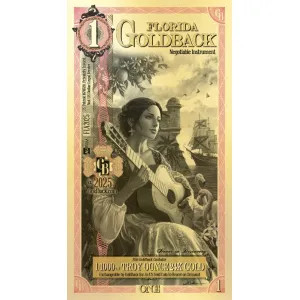The Florida One Goldback depicts the virtue “Harmonia” (Harmony) through the figure of a Spanish settler, embodying the delicate balance between nature, culture, and history during Florida’s early colonization. She wears cross-shaped earrings, symbolizing the Catholic faith carried by Spanish settlers on their voyages. Founded in 1565, St. Augustine features prominently, representing the determination of settlers who established the foundations of European civilization in the New World. In the background, the historic Castillo de San Marcos stands as a powerful emblem of strength. Built between 1672 and 1695 to protect St. Augustine, this fort is the oldest European settlement in the United States, serving as a reminder of the settlers’ resolve to secure their foothold in “La Florida.” A Spanish galleon, flying the Florida Flag and the Spanish Cross, sails on the horizon—a testament to the bravery of those who ventured across the seas to the New World.
Lush native flora surrounds Harmonia, showcasing the settlers’ efforts to coexist with Florida’s natural beauty. The sabal palm, Florida’s state tree, symbolizes endurance and resilience, mirroring the settlers' spirit. The orange tree, bearing Florida’s state fruit, reflects the state’s agricultural legacy and economic growth. St. Augustine, believed to be the site of the first orange trees in Florida, marked the start of a citrus industry central to the state’s economy. The orange blossom, Florida’s state flower, adds grace to the scene, symbolizing renewal and growth.
In the foreground, a Spanish guitar engraved with “Terra Incognita” (Latin for “unknown land”) highlights the courage required to venture into uncharted territory. The guitar, an icon of Spanish culture, serves as a bridge between the settlers’ heritage and the unfamiliar world they encountered, reflecting the merging of Old and New World traditions.
From the flamingo to the orange tree, each detail underscores the settlers’ success in building a life in harmony with their surroundings. Harmonia stands as a tribute to the enduring legacy of those who embraced both land and culture in Florida, affirming the principle that there is “honor in discovery.”








